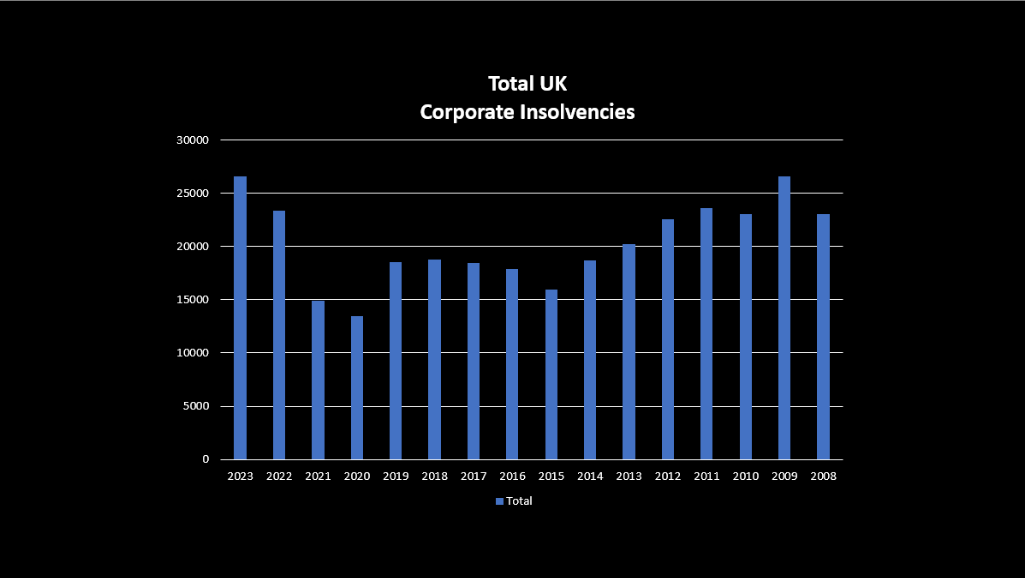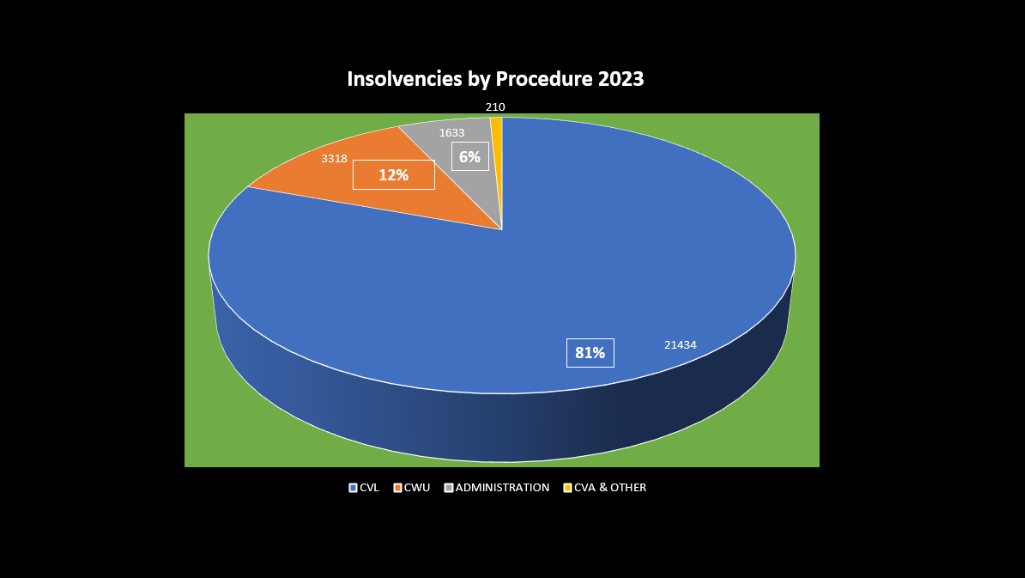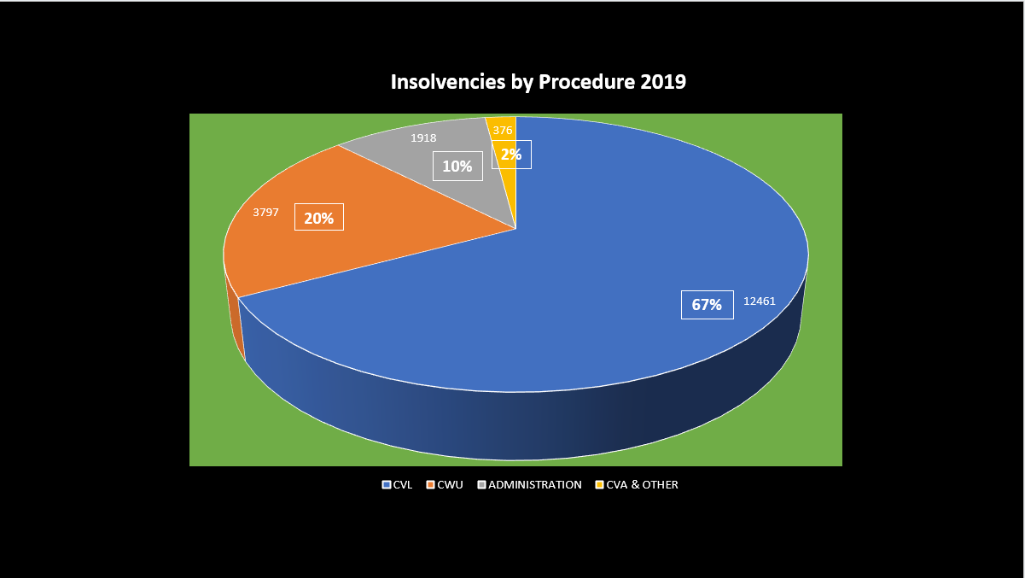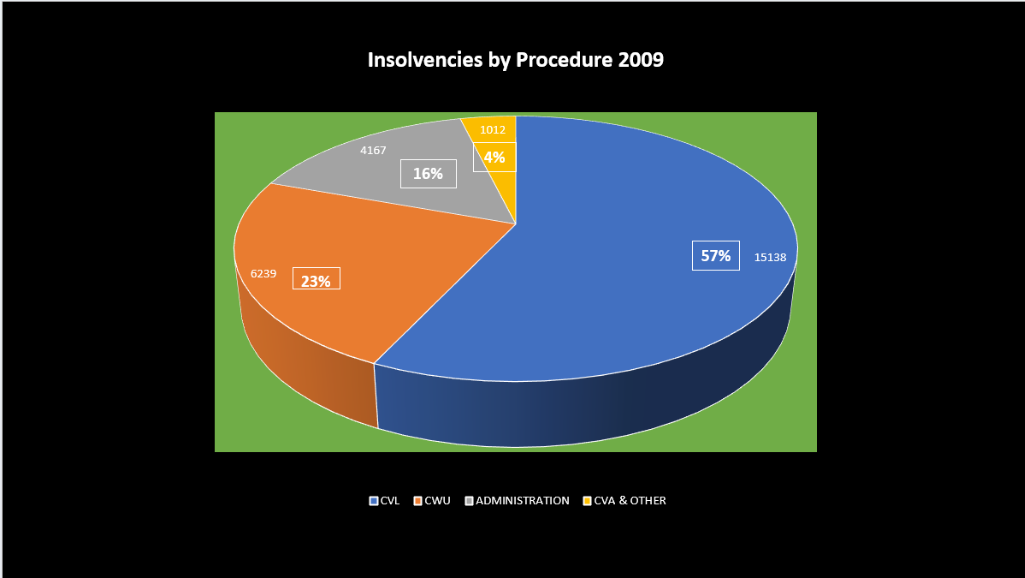
2023 was the worst year on record for company insolvencies
23 January 2024
Insolvency Service statistics have now confirmed that total corporate insolvencies in 2023 eclipsed 2009 as the highest annual total ever for the UK. There were 26,595 failures last year, compared to the previous record of 26,556. This graphic illustrates the trend since 2008:

Overall, the figures for 2023 are 14% higher than 2022 and 43% more than the pre-pandemic outcome in 2019.
Two aspects of the 2023 numbers are striking, showing that economic and commercial circumstances have fundamentally changed the shape of the UK corporate insolvency market.
Business rescue is out of favour
Formal business rescues through the Administration process are in significant decline, dropping from 4,167 (23%) in 2009 to only 1,633 (6%) in 2023. This is not only the result of the pandemic and subsequent economic issues, with the 2019 figure being 1,918 or 10% of the total.
It may reflect a longer-term trend for entrepreneurs to wait longer before seeking professional advice about business and cash flow problems, to the point where some businesses that might have been rescued have been allowed to get past the point of no return.
The continuing fall since the pandemic struck may be down to less enthusiasm for business rescue in such uncertain times and in the context of the UK’s entrenched low growth profile. Too many company balance sheet are in a poor state after such an extended period of commercial challenge.
It is also possible that the amount of rescue funding available has shrunk. There have been suggestions that some financial resources have been diverted to less risky projects involving funding the ‘tidying up’ large corporate groups through asset disposals of non-core activities.
CVLs dominate
There has been a striking increase during and since the pandemic in the number of Directors or Shareholders calling it a day but seeking to retain at least some control over their destinies by going down the Creditors’ Voluntary Liquidation (CVL) route, recognising that things have gone beyond any reasonable hope of a business rescue.
Last year, 81% of all company failures were CVLs. This compares to 67% in 2019 and only 57% in 2009. The effect of successive economic shocks starting with the pandemic and continuing with the Ukraine war and then the cost of living crisis can be seen in this trend. Sharply increased debt burdens taken on by many smaller companies during the pandemic are another factor.
The shape of the market
The relative changes in which particular corporate insolvency process is being deployed is shown by these graphics:



Which sectors were worst hit?
As with every other year, construction has suffered the most failures, the sector representing 17% of corporate insolvencies last year, though this was a slight improvement from 19% in 2022. Two industries very much at the sharp end of reduced consumer spending capacity and pandemic disruption come next: hospitality at 15% and retail at 12%. Manufacturing and professional services were fourth and fifth, seeing 8% of 2023’s company insolvencies.
The challenges facing businesses
There has been an almost obsessive focus in the media on the problems created for businesses variously by the pandemic, the knock on effect of the Ukraine war and now the cost of living crisis and rapid rise in interest rates.
In reality, many potential problems had long been entrenched in both the economy and the commercial prospects for industry sectors and the companies operating within them by decades of chronic under-investment. This has not just shackled the economy’s ability to grow, but seriously damaged productivity and competitiveness.
No part of the finances and business models of companies has been unaffected by these various negative influences. Top line revenues have fallen as consumer spending has reduced. Profit margins have been slashed by input cost inflation. Soaring staffing costs and other cost rises have pushed up overheads. The tight labour market has denied businesses the staffing resources they need. Servicing borrowings has become much more difficult as the ultra-cheap money era has ended.
No wonder many small businesses have hit the wall, overwhelmed by insuperable cash flow issues, neutered profitability and wrecked balance sheets.
Will 2024 be better or worse?
Stakeholders at the sharp end of business risk such as the trade credit insurer, Atradius predict another rise in insolvencies this year but at a lower rate of escalation. They suggest that 2024 could be another record breaker, with a total of 28,000 failures.
This forecast was published before the latest geopolitical crisis in the Middle East but equally, it cannot reflect the impact of any pre-election measures designed to stimulate the UK economy.
Proactivity remains paramount
Whatever happens in 2024, the core advice for all those running struggling businesses is to get independent professional advice at the earliest possible opportunity and equally importantly, to follow it. Delay restricts and eventually eliminates positive outcomes.
 Nick Hood
Nick Hood
Senior Business Adviser, Opus Business Advisory Group
R3 members can provide advice on a range of business and personal finance issues. To find an R3 member who can help you, click below.

 Stuart McBride
Stuart McBride Amelia Franklin
Amelia Franklin Lyle Horne
Lyle Horne
